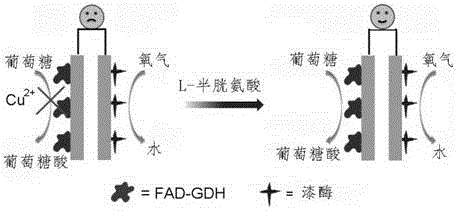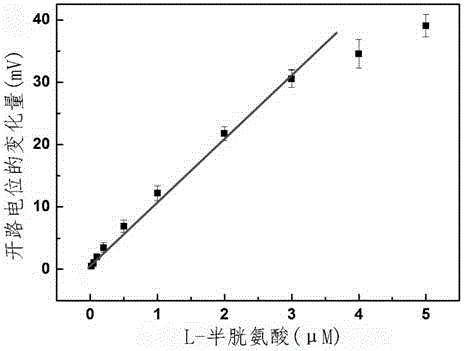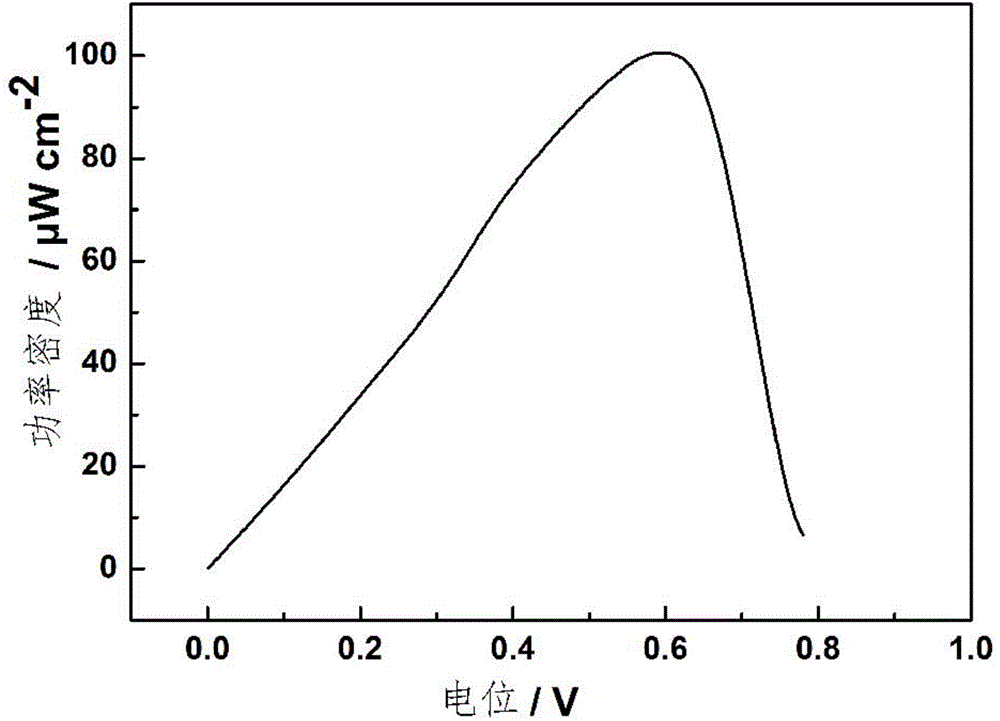Method for quantitative detection of L-cysteine
A technology for quantitative detection of cysteine, applied in measuring devices, material analysis through electromagnetic means, instruments, etc., can solve the problems of miniaturization and high technical requirements of electrochemical workstations, achieve low cost, improve sensitivity, The effect of high sensitivity
- Summary
- Abstract
- Description
- Claims
- Application Information
AI Technical Summary
Problems solved by technology
Method used
Image
Examples
Embodiment 1
[0018] Construction of glucose / oxygen biofuel cell
[0019] 1. Preparation of bioanode
[0020] Add 4μL of multi-walled carbon nanotubes (2mg / mL), 5μL of vitamin K 3 And 10μLFAD-GDH solution (5mg / mL) were successively dripped on the glassy carbon electrode, and after drying, 5μL of Nafion solution (0.05wt%) was dripped. Dry at room temperature to prepare a bioanode based on FAD-GDH.
[0021] 2. Preparation of biocathode
[0022] 4μL of multi-walled carbon nanotubes (2mg / mL) and 10μL of laccase solution (5mg / mL) were successively drip-coated on the glassy carbon electrode and dried. Then, 2 μL of glutaraldehyde solution (2wt%) was added dropwise and dried at 4°C to prepare a biocathode based on laccase.
[0023] Insert the bioanode and biocathode into 5mL acetic acid-sodium acetate buffer (pH5.5) to assemble the biofuel cell, use 30mM glucose as fuel, and add 2mMABTS as electron mediator, using CHI660E electrochemical workstation, using linear sweep voltammetry Method (LSV), sweep fro...
Embodiment 2
[0025] Utilizing the constructed glucose / oxygen biofuel cell, in Cu 2+ In the presence of, high sensitivity detection of L-cysteine is realized:
[0026] Add 4μM Cu to the battery of the above example 2+ , And then use a multimeter to detect the open circuit potential of the battery. Then add different concentrations of L-cysteine and record the corresponding open circuit potential value. Finally, draw the standard curve with the concentration of L-cysteine as the abscissa and the change of the open-circuit potential as the ordinate. A straight line can be obtained and its slope can be obtained, which is the slope of the working curve of L-cysteine. The linear relationship between the change in potential and the concentration of L-cysteine (see image 3 ).
[0027] The working curve of L-cysteine is as figure 2 As shown in the figure, the R of the working curve 2 The value reaches 0.997, and the linear fit is very good.
[0028] That is, the detection range is 20nM-3μM,...
Embodiment 3
[0030] Determination of L-cysteine content in a local brand of L-cysteine composite tablets:
[0031] 1. Sample processing: Take an appropriate amount of a local brand of L-cysteine composite tablet, grind and dissolve it in ultrapure water, filter it with a 0.22μm disposable filter membrane, and use 100mM acetic acid-sodium acetate buffer ( pH5.5) Carry out dilution and constant volume.
[0032] 2. L-cysteine detection process: use 5mL acetic acid-sodium acetate buffer (pH5.5) containing 30mM glucose and 2mM ABTS as the base solution to assemble the fuel cell, and add 4mMCu to the base solution 2+ Measure the open circuit potential OCP of the system 1 , And then successively add different volumes of L-cysteine samples to the base solution, and measure the open circuit potential OCP respectively 2 .
[0033] 3. Calculation of L-cysteine concentration: take the change of open circuit potential (OCP 2 –OCP 1 ) Calculate the dilution ratio within the range of the standard cu...
PUM
 Login to View More
Login to View More Abstract
Description
Claims
Application Information
 Login to View More
Login to View More - R&D
- Intellectual Property
- Life Sciences
- Materials
- Tech Scout
- Unparalleled Data Quality
- Higher Quality Content
- 60% Fewer Hallucinations
Browse by: Latest US Patents, China's latest patents, Technical Efficacy Thesaurus, Application Domain, Technology Topic, Popular Technical Reports.
© 2025 PatSnap. All rights reserved.Legal|Privacy policy|Modern Slavery Act Transparency Statement|Sitemap|About US| Contact US: help@patsnap.com



